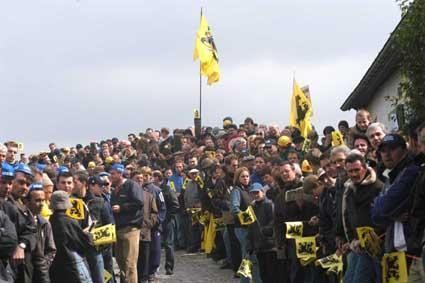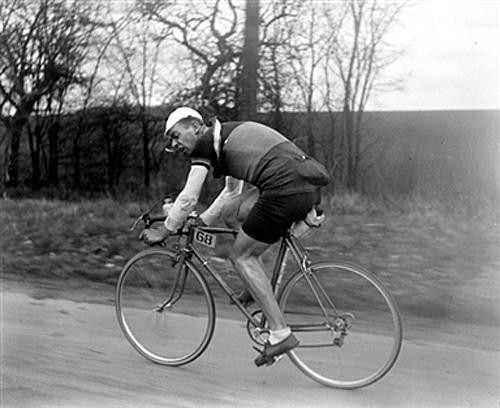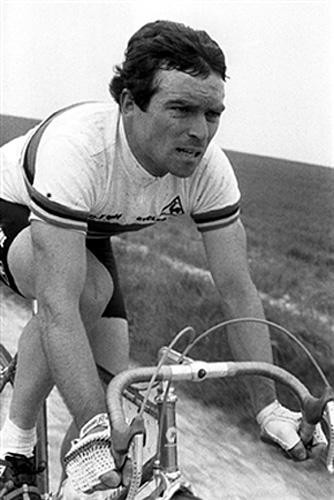The essence of 'de Ronde'
As the season heads into the heart of the Spring Classics it's time to focus on Belgium and a race...



Tales from the cobbled peloton, April 1, 2006
As the season heads into the heart of the Spring Classics it's time to focus on Belgium and a race which captures the imagination of most cycling enthusiasts - the Tour of Flanders. Cycling historian Les Woodland takes a look at what makes de Ronde van Vlaanderen so special.
I bet your local bike race doesn't have rock-style merchandise. But that's because it's not the Tour of Flanders, the race that belongs to Belgium and the people of the bike-crazy north. Because as everyone knows, heaven keeps a special place for Flandrians who win.
So, you want to time the break? What better than your own Ronde wristwatch from Rodania, including "a sport version provided with hour, minute and second hands, date, heavy rust-free metal body, shock-resistant mechanism and shatterproof glass, tested at 100 metres below water, equipped with massive rust-free steel strap with double slot for safety"? Or perhaps you're better at guessing the future than timing the present. OK… name the first three in the right order and you'll receive a hefty prize from Eddy Merckx. But be warned: you'll be one of more than 80,000 sending a prediction to Het Nieuwsblad, the organising newspaper.
The Tour of Flanders was the invention of Karel van Wijnendaele, whose actual name was Karel Steyaert (He chose Van Wijnendaele to reflect where he was born). He was born in 1882 and became a bike racer and journalist who for 20 years ran Belgium's team in the Tour de France.
He and his paper, Sportwereld, wanted a Flemish race to rival Liège-Bastogne-Liège in the south. A century ago, the French-speaking south had the power and the money. Now the position is reversed but the bitterness remains. Van Wijnendaele's race is as much a political statement today as when it started two weeks before Easter 1913. When you see those waving yellow flags printed with black lions, remember they are symbols not of Belgium but of Flanders and that for many they are the flag of Flemish separation.
Van Wijnendaele organised his race by getting out a map of the empty roads of Belgium and drawing a loop where he fancied going. He told towns to expect a bike race but the roads were so bad that he knew riders would be torn to shreds in the wind long before big bunches could race through towns busy with horses and farmers.
Get The Leadout Newsletter
The latest race content, interviews, features, reviews and expert buying guides, direct to your inbox!
There were more cobbles then than now, and they are nowhere near as bad today. In those days they were mis-shaped and at different heights and there were snaking tram lines to catch riders' wheels, but that meant most roads had gravel paths beside them and it was on those rather than the cobbles that the riders thrashed in long lines, trying to hold their place in the wind.
Unfortunately it was such a spectacle that every driver in Flanders joined in. There weren't that many cars in northern Belgium but they caused such huge jams year after year that it often looked as though every single one was at the race. The police went out on motorbikes and fined drivers but it made little difference and they parked two and sometimes three deep on the climbs. Only fuel rationing in the war ended it.
Wartime defeat was swift for Belgium. Belgians went to bed on May 9 in a neutral country and woke to find Germans on the street. Rik van Steenbergen remembered it as a time of racing with what equipment you could get, and smuggling what you lacked. "Smuggling for many people was a way of living. Prizes were always in kind rather than cash, but everyday things were more scarce than the money to buy them and so we didn't mind", he said.
"When I turned pro in 1945, I couldn't ride the Tour of Flanders straight away. There were three categories of rider: road riders A, road riders B, and track riders. I was registered with the federation as a track rider. At first they wouldn't let me ride the national championship. But Jean van Buggenhout, the manager, got me reclassified on the Wednesday before the race. I won it and became an 'A' rider. Then I could start the year in the Tour of Flanders. I was 19 and I'll probably stay the youngest person ever to win."
With peace, towns and provinces began asphalting roads, taking pride in their recovery. But think of Belgian bike racing, and you think of cobbles. They were missed. They'd become the trademark of the Tour of Flanders. Van Wijnendaele flapped when he heard that asphalting had begun on some of the classic climbs and he bought maps of every track and footpath in the north and sent out helpers to find old boys in bars who knew the real back roads of their region. "It was either that or risk the race ending in a mass sprint, and that's the last thing they wanted," says the historian Tom van Laere.
The length of cobbles got less but their quality got worse. The roads the menders were most likely to have left alone were those that could be passed only by tractor, which meant they were often steep as well. And the more those tractors and machines passed, the worse the roads became. To be honest, it was just what the fans wanted. They raced from hill to hill to watch riders touch wheels and fall and then run with scraping shoes as they struggled on the tractor's width of steep cobbles between gutters and grass banks.
The Koppenberg got most riders off from 1976 until 1987. In 1984 only Phil Anderson and Jan Raas got up without walking. Things went too far when Jesper Skibby fell and the organiser's car ran over his back wheel. Town officials in Oudenaarde weren't impressed. If a bike could be mangled, so could a rider's foot. The hill was dropped.
Bernard Hinault called the Koppenberg a cochonnerie, a foul joke. He rode in 1978 and never went back. "I told the organisers it wasn't a race but a war game. Instead of a race, it's a lottery," explained the five-time Tour de France winner. The Kluisberg was tried in 1955, abandoned until 1966 and didn't reappear until 1992. The 1,600m of the Oude Kwaremont arrived in 1974, the Bosberg and the Taaienberg were introduced in the mid-1970s and Berendries only in 1983.
Het Nieuwsblad, which took over Sportwereld in 1939, often varies the route. At first it was a circuit from Ghent to the suburb of Mariakerke. Then it started outside the town hall in Sint-Niklaas marketplace, the biggest square in Belgium, and finished on the old Ghent track. Since then it's moved to Brugge, known to many by its French name of Bruges.
It rains no more in Flanders than in neighbouring countries, including England. But it's when the weather turns foul that legends are born. Fiorenzo Magni in 1950 and 1951, for instance. And Eddy Merckx attacking alone for 70km in 1969 as cold, rain and night fell all around. And 1985, when Eric Vanderaerden won and only 24 riders reached the finish - fewer than there were prizes.
That's the essence of the Ronde. Wagner couldn't have done it better.